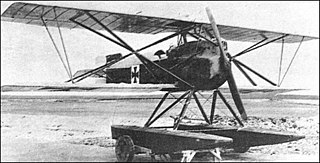Luftverkehrsgesellschaft m.b.H. was a German aircraft manufacturer based in Berlin-Johannisthal, which began constructing aircraft in 1912, building Farman-type aircraft. The company constructed many reconnaissance and light bomber biplanes during World War I.

The Hansa-Brandenburg KDW was a German single-engine, single-seat, fighter floatplane of World War I. The KDW – Kampf Doppeldecker, Wasser – was adapted from the Hansa-Brandenburg D.I landplane to provide coastal defence over the North Sea.

The Roe I Triplane was an early aircraft designed and built by A.V. Roe which was the first all-British aircraft to fly..

The Roe IV Triplane was an early British aircraft designed by Alliott Verdon Roe and built by A.V. Roe and Company. It was first flown in September 1910.

The Gotha G.VIII, GL.VIII, G.IX, and G.X were a family of bomber aircraft produced in Germany during the final months of World War I. Based on the Gotha G.VII, they were intended as high-speed tactical bombers featuring advanced streamlining for their day.
The Schütte-Lanz D.III was a German fighter prototype during World War I. It participated in the first Idflieg D competition at Adlershof, Germany in January and February 1918. It was a conventional single-bay staggered biplane with N-type interplane struts. Of wooden construction with fabric skinning, the D.III revealed an unspectacular performance and production was never continued.

The Zeppelin-Staaken Riesenflugzeuge were a series of very large bomber aircraft - Riesenflugzeuge, usually powered by four or more engines, designed and built in Germany from 1915 to 1919.

The Kondor D 7 was a prototype German single seat biplane fighter built over the winter of 1917-18. It was not a success and its development was soon abandoned.

The LFG Roland D.IV, later redesignated LFG Roland Dr.I was a German single engine, single seat triplane fighter flown in mid-1917. It produced no performance or operational advantages over existing types and only one was built.

The LFG Roland D.IX was a World War I German single seat fighter aircraft, a biplane powered by one of a new generation of powerful rotary engines. Three slightly different prototypes were built but there was no series production.

The LFG Roland G.I was a large prototype single-engine biplane bomber built in Germany in 1915, during World War I. It had a single engine buried in the fuselage driving pusher configuration propellers mounted on outriggers.

The Schütte-Lanz G.I was a large, twin engine, pusher configuration, experimental biplane built in Germany early in World War I. Only one was completed.
The Schütte-Lanz D.VI was a single engine, parasol wing fighter aircraft designed and built in Germany towards the end of World War I. It had a very short career, crashing on its first flight.
The Schütte-Lanz D.VII was a single engine, biplane fighter aircraft designed and built in Germany towards the end of World War I.
The Albatros C.VIII N was a German large, single engine biplane bomber, intended for night time operations, It was seriously underpowered and could only carry a small bomb load.

The Albatros C.XIV was a German two seat, single engine, biplane fighter aircraft built in 1918. Only one was constructed.

The Siemens-Schuckert L.I was a large, three-engined biplane bomber aircraft, built in Germany towards the end of World War I. It was a twin boom design, strongly influenced by the successful Caproni Ca.3. Three were built but not used operationally.

The Zeppelin-Lindau Gs.I, often known post-WWI as the Dornier Gs.I after its designer Claude Dornier, was a civil flying boat developed immediate post-war from a military prototype. Its passenger cabin seated six. Only one was completed, and that was eventually scuttled to keep it out of Allied hands. Another of the military prototypes was intended to have a bigger, nine seat cabin and other refinements but the Gs.II was incomplete when discovered by Allied inspectors.

The Zeppelin-Lindau V I was a metal-framed, pusher configuration, German sesquiplane, designed by Claude Dornier. It flew on 13 November 1916 and crashed on the first flight.

The Kawanishi K-6 was a passenger-carrying biplane floatplane, built in Japan in the 1920s. The sole example took part in an around Japan flight then flew as a transport with Japan Aviation.















